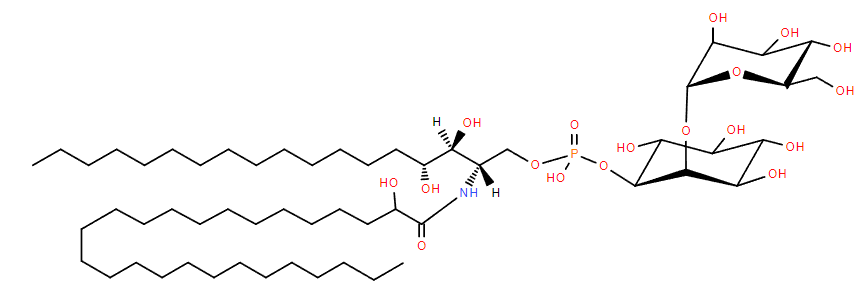Ceramides (Cer) and Phosphoceramides
Class abbreviations
| Common Name | Lipid Class | Abbreviation |
|---|---|---|
| Ceramides | Ceramides | Cer |
| Ceramide-phosphates | Ceramide phosphates | CerP |
| Acyl Ceramides | Acylceramides | ACer |
| Sphingomyelins | Ceramide phosphocholines (sphingomyelins) | SM |
| Ethanolaminephosphorylceramides | Ceramide phosphoethanolamines | CerPE |
| Glycosylinositolphosphorylceramides | Ceramide phosphoinositols | GIPC |
| Mannosyl-inositolphosphoceramides | Ceramide phosphoinositols | MIPC |
| Mannosyl-diinositolphosphoceramide | Ceramide phosphoinositols | M(IP)2C |
Specific rules for Ceramides (Cer) and Phosphoceramides
- In ceramides the sphingoid backbone is annotated C-atoms:DBE;O-atoms separated by a slash from the number of C-atoms:DBE;O-atoms of the N-linked fatty acid, e.g. Cer 18:1;O2/16:0.
- Double bond geometry is annotated in parentheses and other functional groups are preceded by the position numbers, e.g. Cer 18:1(4E);1OH,3OH/16:0. Further characterization of N-linked fatty acid is done as described for fatty acyls.
- A fatty acid esterified to an N-linked hydroxy-fatty acyl is shown in a separate pair of parentheses xO(FA C-atoms:DBE) with x denoting the position of hydroxyl group (∆ nomenclature) in the N-linked fatty acids, e.g. Cer 18:1;O2/26:0;18O(FA 16:0).
- Fatty acyl modification of a sphingoid base-OH is written in front of (sub)class abbreviation with integrated position number in brackets at the end of abbreviation, e.g. FA 24:1-Acer[1] 18:1;3OH/16:0.
- Ceramide phosphates with unknown phosphate position are represented by CerP, e.g. CerP 18:1;O2/16:0.
- Ceramide phosphates with known position of phosphate and of OH-positions are annotated by, e.g., CerP[1] 18:1(4E);3OH/18:0.
- Ceramide phosphates with 1,3 cyclic phosphate and known OH-positions are annotated by, e.g., CerP[1,3] 18:1(4E)/18:0.
- Consequently, in shorthand notation from Structure defined level onwards only unmodified OH-groups of the sphingoid base are annotated
- The same applies to sphingomyelin (SM), it contains by definition the phosphocholine group, due to modification of the 1OH-group.
Hierarchical shorthand notation for examples of sphingolipids containing an amide-bound fatty acid
Species level: Sum composition, Molecular species level: Lipid species with identified SPB and N-acyl residue, Full structure level: Molecular species with constituents and functional groups including positions.
| Phyla | Species level1 | Molecular species level | Full structure level |
|---|---|---|---|
| Mammalian | Cer 34:1;O2 | Cer 18:1;O2/16:0 |
Cer 18:1(4E);1OH,3OH/16:0

|
| Mammalian | Cer 34:0;O2 | Cer 18:0;O2/16:0 | Cer 18:0;1OH,3OH/16:0 |
| Mammalian | ACer 58:1;O2 | FA 24:1-ACer 18:1;O2/16:0 | FA 24:1-ACer[1] 18:1(4E);3OH/16:0 |
| Mammalian | CerP 34:1;O2 | CerP 18:1;O2/16:0 | CerP[1] 18:1(4E);3OH/16:0 |
| Mammalian | SM 36:2;O22 | SM 18:2;O2/18:0 |
SM[1] 18:2(4E,14Z);3OH/18:0

|
| Mammalian | SM 44:2;O22 | SM 20:1;O2/24:1 | SM[1] 20:1(4E);3OH/24:1(15Z) |
| Mammalian | Cer 62:3;O4 |
Cer 18:1;O2/26:0;O(FA 18:1) Cer 18:1;O2/44:2;O2 |
Cer 18:1(4E);1OH,3OH/26:0;26O(FA 18:1(9Z)) |
| Yeast | Cer 44:0;O5 | Cer 18:0;3O/26:0;O2 | Cer 18:0;1OH,3OH,4OH/26:0;2OH,3OH |
| Plant | IPC 42:1;O4 | IPC 18:1;O3/24:0;O |
IPC[1] 18:1(8E);3OH,4OH/24:0;2OH

|
| Plant | HexA-IPC 42:1;O4 | HexA-IPC 18:1;O3/24:0;O | GlcA-IPC[1] 18:1(8E);3OH,4OH/24:0;2OH |
| Plant | HexHexA-IPC 42:1;O4 | Hex-HexA-IPC 18:1;O3/24:0;O | Glc-GlcA-IPC[1] 18:1(8E);3OH,4OH/24:0;2OH |
| Plant | HexAHexNAc-IPC 42:1;O4 | HexNAc-HexA-IPC 18:1;O3/24:0;O | GlcNAc-GlcA-IPC[1] 18:1(8E);3OH,4OH/24:0;2OH |
| Plant | HexHexAHexNAc-IPC 42:1;O4 | Hex-HexNAc-HexA-IPC 18:1;O3/24:0;O | Glc-GlcNAc-GlcA-IPC[1] 18:1(8E);3OH,4OH/24:0;2OH |
| Yeast | MIPC 44:0;O4 | MIPC 18:0;O3/26:0;O |
MIPC[1] 18:0;3OH,4OH/26:0;2OH

|
| Yeast | M(IP)2C 46:0;O4 | M(IP)2C 20:0;O3/26:0;O | M(IP)2C[1] 20:0;3OH,4OH/26:0;2OH |
1 Annotation based on exact mass measurements using a high-resolution mass spectrometer.
2 Annotation using low resolution MS QQQ and a PIS m/z 184 requires the assumption of a sphingoid base with two hydroxyl groups.
2 Annotation using low resolution MS QQQ and a PIS m/z 184 requires the assumption of a sphingoid base with two hydroxyl groups.